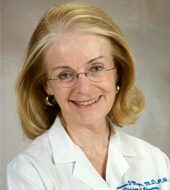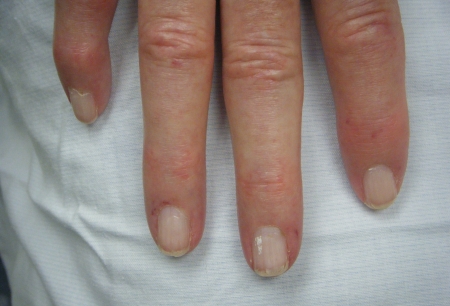Summary
Definition
History and exam
Key diagnostic factors
- Raynaud phenomenon
- digital pits or ulcers
- swelling of the hands and feet
- skin thickening
- loss of function of hands
- sclerodactyly
- heartburn, reflux, and dysphagia
- bloating
- fecal incontinence
- arthralgias and myalgias
- abnormal nail-fold capillaroscopy
- telangiectasia
- subcutaneous calcinosis
- dyspnea
- dry crackles at lung bases
- tendon friction rub
- abrupt onset moderate/marked hypertension
Other diagnostic factors
- fatigue
- dry cough
- decreased exercise tolerance
- weight loss
- inflammatory arthritis
- proximal muscular weakness (inflammatory myositis)
- synovitis
- increased accentuation of the pulmonic component of S2 heart sound
- signs of anemia
Risk factors
- family history of scleroderma
- immune dysregulation (e.g., positive ANA)
- exposure to environmental substances and toxins (e.g., silica dust or solvents)
Diagnostic tests
1st tests to order
- serum autoantibodies
- CBC
- BUN and serum creatinine
- ESR
- CRP
- urine microscopy
- complete pulmonary function tests (spirometry, lung volumes, and diffusing capacity measurement)
- ECG
- echocardiogram
- high-resolution CT scan of chest
- barium swallow
Tests to consider
- chest x-ray
- upper gastrointestinal endoscopy ± biopsy
- serum muscle enzymes
- electromyogram/nerve conduction studies
- muscle biopsy
Treatment algorithm
scleroderma renal crisis
cardiac tamponade
Raynaud phenomenon: no ulcers
Raynaud phenomenon: with digital ulcer development
generalized skin involvement
GI involvement
myopathy
synovitis, tendon friction rub, or inflammatory arthritis
interstitial lung disease
pericardial effusion
pulmonary arterial hypertension
Contributors
Authors
Maureen D. Mayes, MD, MPH

Professor of Medicine
Division of Rheumatology and Clinical Immunogenetics
University of Texas Health Science Center
Houston Medical School
Houston
TX
Disclosures
MDM is an advisory board member for Boehringer-Ingelheim, Galapagos, Corbus, the US Medical and Advisory of Scleroderma Foundation, and Eicos. MDM is on the grant review board for Medtelligence. She receives royalties from Oxford University Press and Henry Stewart Talks, and has been paid for consultancy to the Eicos Advisory Board. MDM is an author of a number of references cited in this topic.
Acknowledgements
Dr Maureen D. Mayes would like to gratefully acknowledge Dr Rajpreet K. Arora-Singh, a previous contributor to this topic. RKA declares that she has no competing interests.
Peer reviewers
Mary Ellen Csuka, MD
Associate Professor of Medicine
Department of Rheumatology
Medical College of Wisconsin
Milwaukee
WI
Disclosures
MEC has been reimbursed by: Actelion International (and is a member of its speakers bureau); Encysive Pharmaceuticals; and MediQuest Therapeutics. She is local principal investigator for the SCOT trial, sponsored by NIH.
Jerry Molitor, MD, PhD
Associate Professor
Division of Rheumatic and Autoimmune Diseases
Department of Medicine
University of Minnesota
Minneapolis
MN
Disclosures
JM declares that he has no competing interests.
Bridget Griffiths, MD, FRCP(UK)
Consultant Rheumatologist
Department of Rheumatology
Freeman Hospital
Newcastle Upon Tyne
UK
Disclosures
BG declares that she has no competing interests.
Ariane L. Herrick, MD, FRCP
Reader in Rheumatology and Consultant Rheumatologist
Musculoskeletal Research Group
University of Manchester
Manchester
UK
Disclosures
ALH declares that she has no competing interests.

Differentials
- Primary Raynaud phenomenon
- Localized scleroderma (morphea)
- Mixed connective tissue disease
More DifferentialsGuidelines
- Guideline for the treatment of interstitial lung disease in people with systemic autoimmune rheumatic disease
- Treatment of systemic sclerosis - associated interstitial lung disease
More GuidelinesLog in or subscribe to access all of BMJ Best Practice
Use of this content is subject to our disclaimer